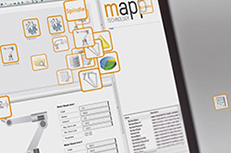To run the ultra-integrated smart factories of Industry 4.0, programmers are having to write increasingly complex software. As they do, the cost of developing and maintaining this software is skyrocketing. Intelligently linked mapp components keep mountains of software from becoming bottomless money pits.
"When it comes to Industry 4.0 implementation, machine builders and owners face a serious challenge: They have an increasing amount of very complex software to manage," says Christoph Trappl, international applications manager at B&R. As we continue to move beyond the limits of what can be achieved with a purely mechanical solution, more and more of a machine's processes are being implemented in software form. Today, software already accounts for around 50% of a newly developed machine. At the same time, it's important to remember that the lion's share of software costs have nothing to do with development. Over the lifecycle of a machine, approximately 70% of the software costs go toward maintenance.

Function blocks fall short
Function blocks and preprogrammed task-specific modules make it easier to write application software but have a limited impact on overall complexity. "That's why we took mapp technology to a much deeper level conceptually," explains Trappl.
One of the central features of mapp technology are what's known as mapp links, which work according to a client-server model. Each mapp component provides data that can be queried as needed. This lets you do things like set up an entire energy management system with a few mouse clicks. When you add the mapp energy component to the application, it automatically retrieves the energy data it needs from all the axes. If you add a new axis, mapp energy incorporates its energy data automatically. This makes it unbelievably easy to work with machine variants and options.

When you add the mapp energy component to the application, it automatically retrieves the energy data it needs from all the axes. If you add a new axis or even a multi-axis CNC machine, mapp energy incorporates their energy data automatically.
Immense savings potential with mapp
mapp energy prepares energy data according to the user's preferences. The graphical editor allows the user to create custom reports and perform dynamic analysis. Relationships between batches, individual products and energy data can be identified, for example, and used to optimize production.
"It may sound trivial," concedes Trappl, "but it harbors an immense potential for savings." Programming an energy management solution used to take days of labor and countless lines of code. The interfaces between each axis and the energy management system had to be programmed individually. "With mapp we've all but eliminated this type of glue code,'" explains Trappl. According to a benchmark study by the independent LIAM institutewww.br-automation.com/smc/d8fa16e36ce14990f40a77fcb7c42bbf2ae1f6cf.pdf mapp was able to reduce the amount of source code by 83%.
Modular concepts for Industry 4.0
"The benchmark test was based on a flying saw application," notes Trappl. "With a modular machine design the potential savings is even greater." If new axes are added, the mapp link ensures that mapp energy incorporates their energy data automatically – even during operation. The other mapp components all work in a similar way. "That's what real Industry 4.0 modularity looks like."
A modular design is necessary, for example, if you want to be able to add or remove optional equipment quickly and efficiently. This requires software that is arranged in mechatronic units, which is no problem at all with mapp. "A great way to illustrate this is by looking at the alarm system for a packaging machine," says Trappl.
Traditionally, if you wanted to add a robotic palletizer to your packaging machine after a year of operation, the code for the palletizer would have to be included in the machine software from day one. Otherwise, you would have to rewrite the software, perform new testing and possibly even obtain new certifications. The packaging machine can only react to alarms generated by the palletizer if it is programmed to do so in the software.
Manage options without programming
The mapp architecture, on the other hand, gives the robotic palletizer its own alarm system – but its data is also available to the alarm system on the packaging machine. The packaging machine can read this data and react to it, even if there were no plans or preparation for the palletizer when the machine was first installed. "You never need to touch the packaging machine software," emphasizes Trappl.
"Hello, service technician, this is the machine speaking"
mapp alarm itself offers many functions that can help minimize downtime. One of them is the ability to have the machine send an automatic text message notification in the event of an alarm. If the recipient fails to respond within a defined period of time, the notification is forwarded to another person. The list of people to be notified can be defined freely and even changed on the fly.
mapp makes room for innovation
mapp's commitment to the modularization of machinery offers decisive advantages for the transition to Industry 4.0. In spite of its increasing complexity, a machine's software remains manageable over its entire lifecycle. Even when production shrinks to batch size 1, machine builders and owners can continue to boost overall productivity.
mapp technology reduces software maintenance costs in two different ways. First, the mapp components themselves simplify the entire machine software and make the code easier to understand. With a code base that is 83% smaller, errors are much easier to find. On top of that, B&R subjects every mapp component to extensive testing and ongoing maintenance. New mapp components are being added all the time and can be integrated seamlessly into existing systems with no additional effort.



"mapp technology takes the modularity of function blocks to a whole new dimension. The intelligent links between the individual components are what give mapp the power to combat software complexity." Christoph Trappl, International Applications Manager, B&R